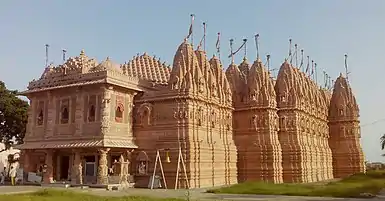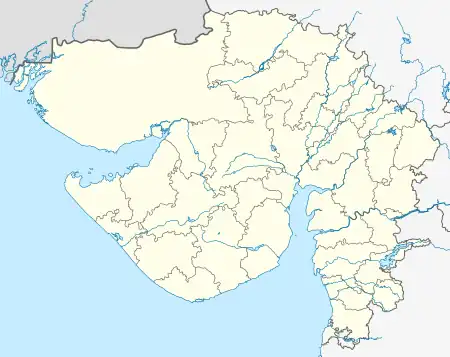Bhadreshwar Jain Temple
Bhadreshwar Jain Temple, also known as Vasai Jain Temple, is a historical importance located in Bhadreshwar village of Mundra Taluka, Kutch, Gujarat, India.[1][2]
| Bhadreshwar Jain Temple | |
|---|---|
 Vasai Jain Temple | |
| Religion | |
| Affiliation | Jainism |
| Deity | Mahavirswami |
| Festivals | Mahavir Jayanti |
| Governing body | Seth Vardhaman Kalyanji Trust |
| Location | |
| Location | Bhadresar, Kutch district, Gujarat, India |
 Location within Gujarat | |
| Geographic coordinates | 22°54′42.1″N 69°54′14″E |
| Temple(s) | 1 |
History
According to Bantvijaya Chronicles, a 19th-century Jain scripture composed by Acharya Bantvijaya, the temples date back to 516 BCE (Vira Nirvana Samvat 12) during the reign of Raja Siddhasen.[3][4] The idol of Parshvanatha was installed by Shri Kapil Kevali Muni in the 5th century BCE.[5][2] The temple was also renovated by King Samprati, of the Maurya dynasty, and installed stone idols elephant outside temple. The temple was later renovated by Vanaraja Chavda, Sarangadeva, Virasena and Harisen.[6][7]
The first reference to this temple dates back to the 8th century.[8] It is said a Jain layman named Devchandra laid the foundation stone of this temple centuries ago. The temple was renovated extensively by Jagdusha in 13th century.[9] Since then, the temple has been renovated nine times and the temple plan expanded to include 52 dev-kulikas. However, the main shrines remain unchanged.[10][11][12]
The temples have been destroyed many times due to natural calamities like earthquakes and the chronicles of Mistris of Kutch, mention that they were the architects and artisans, who renovated temples during the earthquakes of 1819, 1844–45 and 1875.[13][14][15][16]
In the former temple, the lower part was considered the oldest, perhaps about 1170. The temple complex was expanded with the corridors, then the outer wings, then the shrine, and last of all the porch.[11] The temple complex was again completely devastated in earthquake of 26 January 2001, however, it has now been completely rebuilt to as many of the old shrines was destroyed to the extent that it could not be rehabilitated.[4][16]
Architecture

The temple is notable for its architecture, beautiful marble idols and intricate carvings.[17] The temple follows the plan of the Dilwara Temples, Mount Abu. The temple is built in Sekhari school of architecture.[18] The main shrines is a 48 by 85 feet (15 by 26 m) structure standing at the end courtyard and surrounded by 52 sub-shrines with a corridor in front.[2][19] The principal shrine features three pillared domes. On the east entrance of the temple is a porch with another large dome. A low screen wall separates antarala, mandapa, and the entrance of the temple. At the southwest corner and behind the cells on the left side is a row of chambers with cellars entered by lifting flagstones on the floor. In the shrine are three white marble images. The central vedi enshrines an image of Ajitnatha (1565 CE), with the images of Shantinatha (1175 CE) and a seven-hooded image of Parshvanatha (1175 CE) on either side. On the extreme left of the main vedi is an idol of Tirthankara seated with devi and an image of the Shamla (transl. black) Parshvanatha right.[11][16]
The temple premises includes modern structures and a dharamshala.[20][2]
References
Citation
- Publications Division 1959, p. 7.
- GujaratTourism.
- Shokoohy 1988, p. 3.
- Ramani 2010, p. 15.
- Ward 1998, p. 329.
- Burgess 1875, p. 11.
- Burgess 1874, p. 11.
- Ward 1998, p. 328.
- Lodha 2013, p. 428.
- Titze & Bruhn 1998, p. 200.
- Campbell 1880, p. 214.
- Sharma 2014, p. 100.
- Kadia Kashtriya Itihas. Published in 1896.
- Nanji Bapa ni Nondh-pothi Gujarati book,1999 Vadodara. It is a diary of Railway Contracts done by KGK community noted by Nanji Govindji Tank. This book was given Aank Sidhhi award by Kutch Shakti at Mumbai in year 2000. The book has year wise details of Railway lines built by Mistris of Kutch and has a section with photos on Historical Monuments & Architects built by Mistris of Kutch.
- Kutch Gurjar Kshatriya Samaj : A brief History & Glory : by Raja Pawan Jethwa. (2007) Calcutta.
- James Burgess (1876). Report on the Antiquities of Kutch & Kathiawar: Being the Result of the Second Season's Operations of the Archaeological Survey of Western India, 1874-1875. Sindhi Adabi Board. pp. 205–210. Retrieved 27 August 2016. Alt URL Archived 29 August 2016 at the Wayback Machine
- Desai 2007, p. 333.
- Hardy 2002, p. 101.
- Campbell 1880, p. 213.
- Shokoohy 1988, p. 11.
Book
- Burgess, James (1874). Memorandum on the Buddhist caves at Junnar. Bombay: Government Central Press.
- Burgess, James (1875). Memorandum on the remains (PDF). Bombay: Archaeological Survey of India.
- Campbell, James M. (1880). Gazetteer of the Bombay Presidency: Cutch, Palanpur, and Mahi Kantha. Gazetteer of the Bombay Presidency. Vol. 5. Government Central Press.
- Desai, Anjali H. (2007). India Guide Gujarat. India Guide Publications. ISBN 978-0-9789517-0-2.
- Lodha, Jain Chanchalmal (2013). History of Oswals. Panchshil Publications. ISBN 9788192373027.
- Sharma, Monika (2014). Socio-Cultural Life of Merchants in Mughal Gujarat. Partridge Publishing. ISBN 9781482840360.
- Shokoohy, Mehrdad (1988). Bhadreśvar: The Oldest Islamic Monuments in India. Studies in Islamic Art and Architecture. Vol. 2. Brill. ISBN 9789004083417.
- Titze, Kurt; Bruhn, Klaus (1998). Jainism: A Pictorial Guide to the Religion of Non-Violence (2 ed.). Motilal Banarsidass. ISBN 978-81-208-1534-6.
- Ward, Philip (1998). Gujarat–Daman–Diu: A Travel Guide. Vol. 22. Orient Blackswan. ISBN 9788125013839.
Web
- Hardy, Adam (2002). "Śekharī Temples". Artibus Asiae. 62 (1): 81–137. doi:10.2307/3250282. JSTOR 3250282. Retrieved 3 October 2022.
- Ramani, Srinivasan (2010). "Development and Displacement: Resentment in the Kutch". Economic and Political Weekly. 45 (8): 15–18. JSTOR 25664135. Retrieved 3 October 2022.
- Publications Division (22 November 1959). "Akashvani". Akashvani (July-Dec). Vol. 24, no. 47. Publications Division (India).
- "Bhadreshwar". Gujarat Tourism. Retrieved 3 October 2022.
External links
![]() Media related to Vasai Jain Temple at Wikimedia Commons
Media related to Vasai Jain Temple at Wikimedia Commons